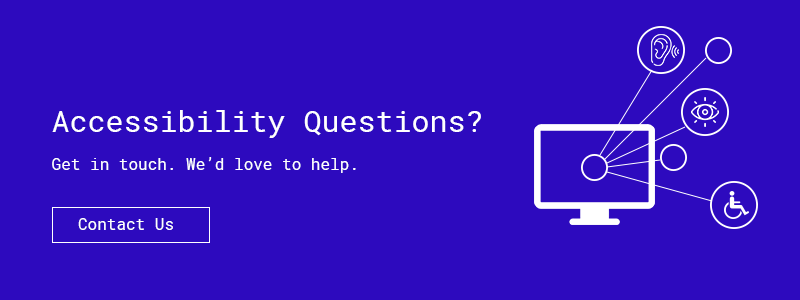Website accessibility has been around long enough for everyone to know what it is… But it has also been around long enough for a lot of unhelpful myths to emerge about accessibility.
So today we’re doing some myth-busting. Here are the 4 most common myths we hear.
Myth #1: Accessibility is expensive (and hard)
This is the most common myth we hear. But let’s dig into this a little bit.
First, what makes it expensive?
The cost of redeveloping a website or building a new app is relatively fixed. Making it compliant or non-compliant might impact the final outcome, but it won’t change how much time/effort it takes to get there.
Second, existing websites.
The same logic applies for rebuilding an existing website, so if it’s in-plan there’s no price difference.
But let’s say it’s not in-plan. Even if you have to rebuild your site when it’s not planned to make it compliant, it doesn’t have to be an expensive fix.
Some simple redesign work, coupled with some back-end changes to make more content available in more formats can get you a lot of ways there.
And this work can overwhelmingly be completed quickly and easily.
Myth #2: Accessibility is the responsibility of the web developers
This myth boils down to this: accessibility is solely the responsibility of the web developers. Designers, content producers, and business stakeholders don’t have to worry about accessibility.
After all, it’s just the code, right?
Wrong.

Website accessibility touches everyone associated with the website. It informs everything from what content is presented, how it’s presented, and the very structure of a site.
For instance:
-
Accessible websites need to meet minimum contrast requirements (graphic design)
-
Accessible websites need to be designed with alternative users in mind (UX design)
-
Accessible content needs to be repurposed quickly and easily to other formats (content)
Clearly, it’s not just up to web development to push through accessible web design.
Myth #3: It makes websites boring
The myth here is that accessible-compliant websites are unable to take advantage of modern web design techniques.
But in reality, this isn’t as big a problem as you might think.
First, a lot of fancy web design is often an excuse to hide poor or under-performing content, that isn’t focused on delivering value, but rather is focused on using the latest tools.
Second, accessibility compliance requirements generally force you to ask:
“Do we really need this?”
A question we think more web designers/developers should be asking themselves.
And finally, you can create an accessible website that lets you use all the wonderful tools available to you with ease.
The things that compliance requirements generally focus on are things like:
-
Websites that are easy to navigate
-
Websites and apps that are easy to see
-
Multiple user paths to the same location
-
Multiple formats for the same content.
… all of which every website or app should have anyways, regardless of design.

Myth #4: You can just use evaluation tools to get it right
The last myth we wanted to talk about was the one around free evaluation tools. There are a lot of tools that can help you evaluate your website/app for compliance requirements. And it’s easy to conclude that those tools are all you need. But that’s not true. While the evaluation tools are a great start, they’re hardly the whole picture.
Generally speaking, they focus on telling you what’s wrong with your digital assets and give you no information on how to fix it. What’s more, it’s unlikely the tool will actually catch everything for every detail needed for an accessible site.
Finally, tools are great for enforcing the technical requirements for accessibility. But accessibility is about so much more than just technical requirements. UX, content, and design all play a role to target this enormous user group, and no box-ticking software is going to get you there.
The solution is to get an accessibility expert, who can give meaningful, concrete tips and examples to help you reach your compliance goals, rather than an arbitrary “accessibility score.”
Wrap up
We see a lot of myths circulating when it comes to accessibility design. Cost, design construction, ownership, and the role tools and calculators play are what we see most often, but there’s a host of others.
That’s why our #1 recommendation is to talk to an expert. They’ll help you cut through the noise (and there is a LOT of noise these days) to identify what you need to do to reach your accessibility goals.
